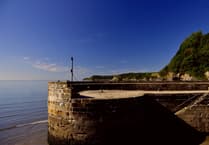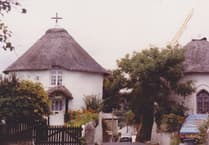MY inlaws have just had a large holm (ilex) oak tree removed from their garden. It was looking good for its estimated age of 120 years, but it had become increasingly apparent that its weight and lean were causing some stress to the wall directly beneath it.
Who knows whether it self-seeded or was deliberately planted there, but because the property falls within a designated conservation area, numerous requests to trim the tree had met with a firm and frustrating refusal, leading to its untamed growth over a busy commuter route into the city.
Perhaps inevitably, earlier this year Cornwall Council issued my inlaws with a dangerous notice letter regarding the state of the wall. Suddenly, everyone was singing from the same hymn sheet: tree and wall had enjoyed a long and harmonious union but were facing sudden and catastrophic divorce, and this would be better conducted in a managed fashion rather than waiting for the next named storm to do the job.
No one was sadder than us about this. This beautiful tree gave us – and the neighbours - shade, shelter and oxygen. It contributed in no small part to the natural environment of our area.
I feared we might see a gaggle of tree-loving protesters with placards, like those in Plymouth and Falmouth, but no. Indeed, had anyone chosen to stand underneath the tree with a banner, I might have been tempted to pull up a deckchair and wait patiently to see how long they were brave enough to stick it out.
But I suspect anyone with eyes could see we wouldn’t undertake the arduous and expensive task of removing such an arboreal titan if it weren’t absolutely necessary. In the toss-up between a green and pleasant environment and the possibility of a tree of considerable tonnage landing on a passing pedestrian or car, pragmatism kicks in pretty sharpish.
I feel much the same about St Paul’s Church in Truro. Poorly-chosen materials – using a soft local soapstone externally in a location as wet and windy as Cornwall - and damage inflicted by a Second World War bomb have taken their toll, and the church closed in 2008 due to safety concerns caused by structural defects.
The decision by Church Commissioners to approve demolition set the cat among the pigeons that now roost in the eaves. A story on Truro Voice’s social media feeds divided opinions: “Churches form the centrepoint of our heritage, and Truro will be less of a place without it,” said one reader, while Steven Webb, city and Cornwall councillor for the Moresk and Trehaverne ward, commented: “Passion doesn’t make buildings safe.”
The finger of blame was pointed at a variety of sources, some more likely than others - from the Church of England and Truro City Council to Sir Keir Starmer himself.
Many felt the Church hadn’t done enough to look after the fabric of the building or find a new buyer during the 18 years St Paul’s has remained empty – the Diocese maintains that several interested parties baulked at the prospect of spending £6-million to bring the building back to a safe and habitable condition.
The idea of the church being converted into a community resource like an arts centre was a popular one. The idea of it being demolished and replaced by housing was categorically not.
I fully understand why people feel such an emotional tie towards St Paul’s. Its tower has been a landmark feature of Tregolls Road for as long as anyone can remember.
Memories have poured in of weddings and baptisms, and children’s clubs in the crypt. My own partner recalls nativity plays and carol concerts in the church, which was tied first to St Paul’s and then Archbishop Benson primary schools.
A churchgoer as a child, I am still a sucker for a beautiful building, a tuneful hymn and the sense of community the church provides. But there comes a point when we have to let go of a much-loved institution and turn our gaze to the future. Churches are about people as much as bricks and mortar, and St Paul’s flock has moved over to St John’s in Lemon Street (itself in need of some TLC).
In an increasingly secular society with dwindling congregations, it’s no surprise the CofE doesn’t like to waste cash on keeping an empty building standing, with 24/7 security to keep teenagers from breaking in for larks.
Bishop Hugh Nelson has described the disused church as a “barrier to the church's mission”. I’d argue it’s time to say let a dear friend rest in peace, and turn our attention to more fruitful endeavours for this site, which might be as valuable to future generations as St Paul’s has been to us.
In the meantime, we mourn our ilex, and my mother-in-law has collected acorns to plant elsewhere (but definitely not on top of walls).


.JPG?width=209&height=140&crop=209:145,smart&quality=75)


Comments
This article has no comments yet. Be the first to leave a comment.